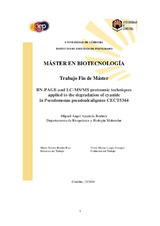Mostrar el registro sencillo del ítem
BN-PAGE and LC-MS/MS proteomic techniques applied to the degradation of cyanide in Pseudomonas pseudoalcaligenes CECT5344
| dc.contributor.author | Aparicio Jiménez, Miguel Ángel | |
| dc.date.accessioned | 2018-01-19T11:08:58Z | |
| dc.date.available | 2018-01-19T11:08:58Z | |
| dc.date.issued | 2018 | |
| dc.identifier.uri | http://hdl.handle.net/10396/15891 | |
| dc.description | Premio extraordinario de Trabajo Fin de Máster curso 2015-2016. Biotecnología | es_ES |
| dc.description.abstract | The cyanide-containing wastewaters from the jewellery industry constitute a serious problem of pollution. The use of cyanotrophic microorganisms is currently proposed as a successful alternative to physico-chemical methods to remove cyanide from polluted areas. Pseudomonas pseudoalcaligenes CECT5344 is a bacterium with a great potential in removing cyanide from the environment, because this strain is able to assimilate cyanide and cyano-derivatives under alkaline conditions. In this work, the BN-PAGE (Blue Native-Polyacrylamide Gel Electrophoresis) technique has been applied to identify proteins complexes induced by cyanide. The results reveal the presence of two possible complexes; complex I that is composed of a phosphoenolpyruvate synthase and DnaK chaperone, and complex II formed by the pyruvate carboxylase and the phosphoenolpyruvate carboxylase. These proteins function to specifically produce oxaloacetate in response to cyanide. Oxaloacetate reacts with cyanide to produce a nitrile, which is converted to its respective carboxylic acid and ammonium by the nitrilase NitC, encoded by the P. pseudoalcaligenes CECT5344 nit1C gene cluster. NitA is a positive transcriptional regulator that responds to cyanide. In addition, a biochemical characterization of the nitA- and nitC- mutants of P. pseudoalcaligenes CECT5344 that are unable to assimilate cyanide has been carried out by analyzing their proteome in response to cyanide. Comparative experimental designs were carried by using the Progenesis IQ software. Thus, the proteomes of all three strains were compared in pairs, nitA- versus wild-type, nitC- versus wild-type and nitA- versus nitC-. The mutant strain nitA- showed induced proteins related to protection against exogenous DNA and general oxidative stress, polyhydroxyalakanoate metabolism and amino acids metabolism, while repressed proteins were related to the Nit1C system, carbon metabolism, metal extrusion system and terminal electron acceptor in respiration. The mutant strain nitC- displayed induced proteins related to nitrogen starvation and general oxidative stress response, while repressed proteins were related to the Nit system, carbon metabolism, metal extrusion system and terminal electron acceptor in respiration. | es_ES |
| dc.format.mimetype | application/pdf | es_ES |
| dc.language.iso | eng | es_ES |
| dc.publisher | Universidad de Córdoba | es_ES |
| dc.rights | https://creativecommons.org/licenses/by-nc-nd/4.0/ | es_ES |
| dc.subject | Cyanotrophic bacterium | es_ES |
| dc.subject | Pseudomonas pseudoalcaligenes CECT5344 | es_ES |
| dc.subject | Cyanide | es_ES |
| dc.subject | BN-PAGE | es_ES |
| dc.subject | Proteomic analysis | es_ES |
| dc.title | BN-PAGE and LC-MS/MS proteomic techniques applied to the degradation of cyanide in Pseudomonas pseudoalcaligenes CECT5344 | es_ES |
| dc.type | info:eu-repo/semantics/masterThesis | es_ES |
| dc.rights.accessRights | info:eu-repo/semantics/openAccess | es_ES |
| dc.contributor.tutor | Roldán Ruiz, María Dolores | |
| dc.contributor.tutor | Luque Almagro, Víctor M. |

